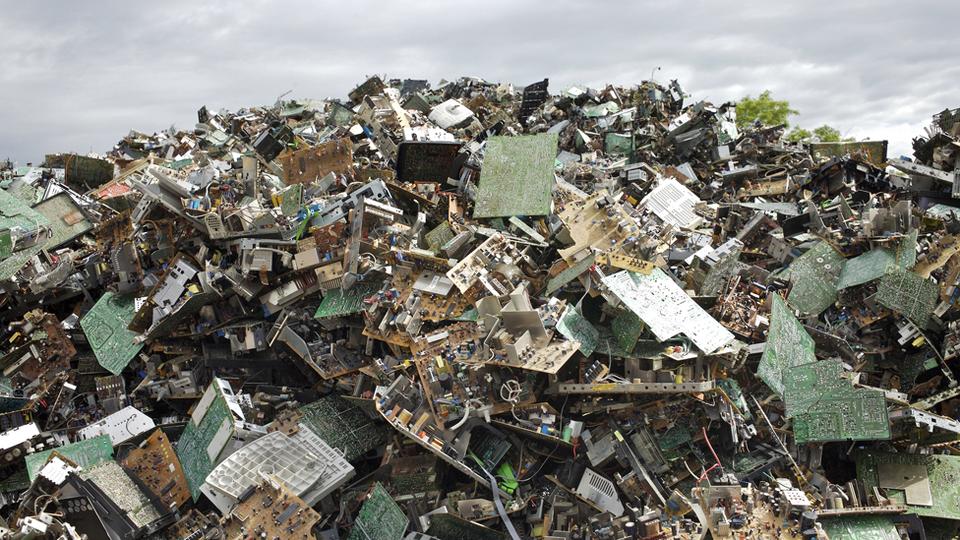Table of Contents
Note: This is an article I originally published in 2018, but due to a new round of right-to-repair legislative action, I feel this is a good time to re-visit the topic.
I am no Luddite: I appreciate the amazing things technology allows us to do, I enjoy having the latest gadgets at my disposal, and I think my hobby of testing, reviewing, and optimizing laptops speaks for itself. So, I hope I don’t sound preachy or alarmist when I say that we cannot allow tech companies to continue their drive of planned obsolescence, perceived obsolescence, and anti-repair practices for the sake of maximizing profit for investors.
First, a little context on this editorial: A 728-page report compiled by 90 leading scientists and commissioned by the UN’s Intergovernmental Panel on Climate Change (IPCC) has been making the news lately for the stark warnings contained within. The report’s main focus is on limiting the increased average temperature to 1.5C above pre-industrial measurements (or an additional 0.5C based on the existing increase of 1C) rather than the 2C (an additional 1C from now) agreed upon by the Paris Accords.
The difference between an additional 0.5C and 1C is that between catastrophic versus apocalyptic: For example, an additional 1C of warming would kill of 99% of the world’s coral reefs — habitats essential to the world’s ecosystem and food chain which feeds anywhere between 600 million and 3.5 billion people, varying by estimates. Optimistically, if the increase is able to be limited to only an additional 0.5C (which is suggested by the report as the absolute best-case scenario at this point) we can look forward to only losing between 70% and 90% of our coral reefs, among a litany of other equally undesirable events. Again, this is the best-case scenario for us at this point, not the worst.
Not long after the UN report made headlines, The Guardian released a piece based on a 2017 report on global emissions, highlighting the fact that 71% of carbon emissions are the result of 100 companies alone, with the majority of them being fossil fuel companies (China coal, for example, is the number 1 emitter with nearly 3 times the total emissions over 1988-2015 of the runner-up, Aramco). This relatively small number of oil & gas companies, along with their investors, are responsible for nearly 3 quarters of global emissions.
Just as a few dozen companies are responsible for the huge majority of global greenhouse gas emissions, a handful of computing companies are responsible for a majority of e-waste.

As more and more of our commodities go high-tech, so does our garbage. Credit: Atlier Bowen
The true cost of our electronics
The World Bank estimates that by 2025, humanity’s average yearly waste output will increase to a staggering 2.5 billion metric tonnes annually (compared to only around 1.2 billion metric tonnes in 2010), and is on track to triple by the end of the century. While electronic waste is estimated to amount to around 40-60 million tonnes each year, research also suggests that electronic waste is growing at an even more rapid pace than regular waste, and the threat of it goes far beyond the physical logistics of where to put all those castaway electronics. A 2015 UN Environmental Program report focusing on illegal disposal of electronic waste highlights a few problems beyond the physical issue of the millions of metric tonnes of electronic waste generated every year itself (last measured at 42 million metric tonnes in 2014). Electronic waste directly damages the air, water, and soil due to the heavy metals, chemicals, and other materials therein, but even more significant are the externalities of the raw materials necessary to make the electronics we take for granted. Research by Princeton estimates the mining of a single tonne of copper requires around 100 million BTU/29,300 kwh of energy. This translates to hundreds of billions of cubic feet of CO2 produced by copper mining per year — and that isn’t even considering the externalities of mining aluminum, gold, and rare earth materials that are the staples of the mobile computing industry.
Thus, recovering or otherwise refurbishing these components and materials is imperative to any effort to sustain something that resembles our current lifestyles — and this is doubly true for the companies thriving off the commodification of consumer electronics. In 2017, Apple released its annual “Environmental Responsibility Report” with the spin that the company, one of the most profitable in the world, was on its way to make its electronics hardware almost entirely out of recycled materials. Companies like Apple are trying to paint themselves as environmentally-friendly actors leading the charge for sustainable electronics, but, as illustrated in an excellent 2017 piece by Vice Motherboard, the fact is that Apple’s mandate of forcing recyclers to pulverize and shred otherwise repairable and salvageable electronics is entirely against best industry practices and results in enormous waste. As iFixit CEO Kyle Wiens notes in the article, breaking down e-waste by shredding should only be used a last resort, though Apple and other companies who want customers buying new products quarterly to appease their shareholders would have you think otherwise. This is not even to mention the direct economic impact on consumers who are cajoled into buying a new machine to replace one that is actually perfectly serviceable for a fraction of the cost of a new one.
The main culprits
It’s hard to determine exactly how much physical electronic waste OEMs produce in absolute terms, but we can make some generalizations by looking at the engineering, business practices, and design philosophies of the top computing OEMs like Lenovo, HP, Dell, Acer, Apple, and recently, Microsoft.
On one end of the spectrum, I would like to take this opportunity to commend companies like Lenovo for offering spare and replacement parts purchases as well as hardware maintenance manuals for their products, which makes third-party service and repair some of the easiest in the industry. Not only that, but much of their business ThinkPad line has consumer-friendly features such as external replaceable batteries, upgradable RAM/SSDs, and easily serviceable designs. While these features are unfortunately becoming less common recently (with the X280, T480s, X1 Carbon, and P1 series losing some key aspects of upgradability), Lenovo still at least offers consumers an outlet to purchase internal components themselves.
More in the middle are the other OEMs like Dell, HP, and Acer, which do offer service manuals for their products, but the parts for those products are significantly harder to come by as only the most basic components are purchasable by mainstream consumers. Still, basic components such as SSDs, hard drives, wireless cards, and (sometimes) RAM are replaceable by the consumer as they are generally not soldered on nor proprietary.
Microsoft is near last here because of their unrepairable and unupgradable hardware designs, of which the Surface Laptop is a solid example of. Despite at least using industry-standard components, the Surface family of laptops and tablets are glued and fused together to the point that they essentially impossible for a consumer to open. You could upgrade the SSD of a Surface laptop or tablet if you could get to it without destroying the product — but they are engineered in such a way that, as iFixit shows in the link above, this is nearly impossible.
As you might have guessed based on what I have written previously, the worst in the mainstream computing industry is likely Apple, which deserves to be directly called-out for their practices of planned obsolescence and anti-consumer behavior, a non-exhaustive list of which includes suing refurbishers, using their T2 chip to attempt to prevent 3rd party repairs, soldering components like the SSD and RAM so they are no longer replaceable, gluing batteries in so they are not easily swappable, denying defects as long as possible (see timestamps for full list), and, of course, fighting ‘right to repair’ legislation.
Before we move on, I’d like to give a special (dis)honorable mention to Intel, who stopped producing upgradable mobile chipsets with the Broadwell (4th generation) series of Core-i CPUs. Yes, you used to be able to upgrade the mobile CPUs in many older lines of laptops just as we can upgrade storage, RAM, and wireless cards in most laptops today. My own conjecture is that people just weren’t upgrading often enough, but there’s no way to know for sure what the real decision-making process behind it was.
How right-to-repair legislation can help reduce waste
When consumers like you and I spend thousands of dollars on computing devices — tools that have become more and more integral to our lives — we like to think we own them. However, the practical reality is that if you are buying a laptop or mobile phone that is not serviceable, you don’t own it: You are just leasing it until your warranty is up and the company is not compelled to provide service and parts to fix it. It could be 3 years or it could be 1 year, depending on the company and the area you live in, but the device is not yours as long as you are unable to fix it yourself.
‘Right to repair‘ legislation seeks to provide 4 main rights to consumers and independent repair outlets, including:
- The right to information such as manuals, schematics, software updates, and licenses.
- The right to parts and tools (necessary hareware/software) at non-discriminatory pricing.
- The right to unlock, adapt, and modify any part of a machine’s hardware or software.
- The right to buy hardware that has been designed with ecological sustainability in mind.
Simply put, your products will have a much longer effective lifespan if you want them to. This is good for the planet (which, let’s be honest, seems to need all the help it can get at this point) and the consumer. Although certain companies that have adapted their business model for quarterly iterative releases of commodified technology will likely suffer initially, the silver lining is that it’s certainly possible to be highly profitable without being completely unethical towards end users. After all, despite making laptops such as the ThinkPad line that are upgradable, serviceable, and eminently repairable, Lenovo seems to be doing okay.
How you can help
First, let your government know that this issue matters to you. If you live in the United States, contact your state representative here. If you are in another country, contact your equivalent representative. Tell them that you bought it, it’s yours, and you deserve to have the right to repair it when it breaks.
Secondly, don’t buy products that are not at least repairable if not upgradable. I frequently get comments on my articles asking for suggestions of laptops to buy, such as whether to buy an Apple Macbook Pro
Thirdly, I will hypocritically suggest not being a tech magpie and try to resist the temptation to buy something just because it has slightly higher numbers than last quarter’s model. There will always be progress in technology, and you will never have the best, fastest, or coolest toy for long; it’s a fool’s game, so try not to play it.
We are living in a time of near complete unsustainability. I feel this is true for humanity from the most basic level of society to the very top. Telling companies that we want to own the products we pay thousands of dollars for is a small but important start.
It’s long past time to start thinking — and I mean seriously thinking — about our environment and all of our individual impacts upon it.
If you have a comment or correction, please share it below. Thanks for reading!
Sources:
https://www.theguardian.com/sustainable-business/2017/jul/10/100-fossil-fuel-companies-investors-responsible-71-global-emissions-cdp-study-climate-change?CMP=fb_gu
http://ipcc.ch/news_and_events/pr_181008_P48_spm.shtml
https://motherboard.vice.com/en_us/article/yp73jw/apple-recycling-iphones-macbooks
https://en.wikipedia.org/wiki/Paris_Agreement
http://web.unep.org/ourplanet/september-2015/unep-publications/waste-crime-waste-risks-gaps-meeting-global-waste-challenge-rapid
https://www.ncbi.nlm.nih.gov/pmc/articles/PMC2796756/
http://fortune.com/global500/
https://ifixit.org/revolution
http://www.worldbank.org/en/news/feature/2013/10/30/global-waste-on-pace-to-triple
https://www.wastedive.com/news/greenpeace-apple-samsung-products-among-biggest-contributors-of-e-waste/446738/













Carlo
October 26, 2018 at 6:31 pm
I did not expect an article like this from a source like this. At the same time, in the back of my head I kept wondering how tech youtubers and other sites think about sustainability because it seems like a paradox. Thank you for this honest, important piece! It makes me think about what really is important to me when buying tech stuff…
Douglas Black
October 26, 2018 at 6:37 pm
I could probably write tons about the business from all sides, but I'm honestly still a hypocrite about it to some degree. Thank you for your complements regardless!
Vincenzo Avignone
August 13, 2019 at 2:27 pm
Thanks for the article, exhaustive, denotes a lot of experience and professionalism. After many years of macOS, I no longer feel like investing in the Macintosh, although it is a simple and intuitive system, and quite productive in the context, but besides the enormous cost of Macintosh machines, there is the great problem of the total irreparability of these. Lenovo is the great example of how it is not true that the parts, such as SSD, Ram, and battery, must be welded, and above all it is also an example of the same Apple, with the new MacPro Modular of 2019. I do not see why given the cost, even the MacBook Pro, they don't even have to be modular. I am considering the purchase of a Lenovo ThinkPad P1
Douglas Black
August 13, 2019 at 2:35 pm
Thank you for your complement and your insight
Carlo
February 2, 2020 at 2:09 pm
Read the article again, still think this is one of the most important pieces of writing on tech FROM A TECH PERSON just because "the tech community" apparently is unable to think about anything else but the price and the features (I am generalizing a tad). I'v been watching several of the biggest techtubers like LTT, MKBH, Dave2D, Unbox Therapy and so on and while some of them like to criticise lack of upgradability, in the couple of years only Linus (AFAIR) managed to actually reflect on the fact that his channel might encourage a wasteful way of living by promoting new tech all the time.
And here I am, typing away on my Butterfly Keyboard, with my Apple Watch on my wrist and iPad Pro nearby.
But enough of the cynicism.
Apple seems to be greener to me because it is part of their branding. That they developed Daisy (I think) to deconstruct traded-in smartphones seems like the way to go. But I guess, repairing should always be the first option.
I agree, it is time to overthink our relationship to tech…
Thanks again!
bittricks
February 16, 2020 at 3:24 am
Right to repair won't help save the environment.
In US and Euro markets, people will lazily just buy another unit even if they do have the right to repair.
Meanwhile, almost the entirety of the 2nd and 3rd world nations have been ignoring OEM's "no right to repair" for decades because they cannot afford to buy new units.
Even with all the self-repair already going on, the environment is being bashed. And the problems with the environment began way back before WWI.
We're gonna be climate-fried before any solution to garbage comes along, so we have much bigger problems at this point.